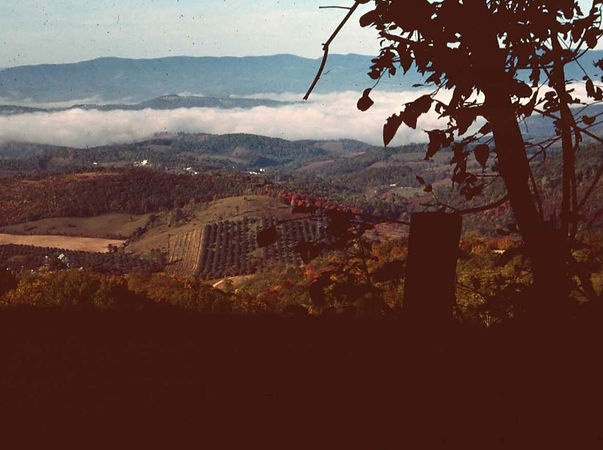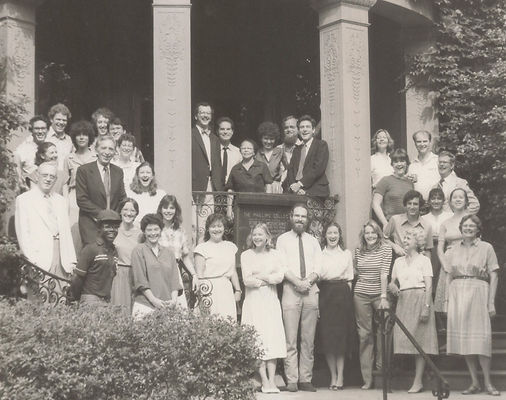
HISTORY
MOUNTAIN LAKE WORKSHOP + SYMPOSIUM
The Mountain Lake Workshop evolved out of the Mountain Lake programs that were begun in 1980 by artist Ray Kass who was then an Associate Professor of studio art at Virginia Polytechnic Institute and State University. Included in these programs were interdisciplinary art criticism symposia, artists’ conferences, and studio workshops. For these programs artists and professionals from the art world and related fields such as religious studies, philosophy, music, sociology, anthropology and psychology were invited to Mountain Lake to participate as lecturers, panelists, and artists in discussions and studio demonstrations about critical issues that had a bearing on contemporary art. For instance, the first symposium was held in October of 1980 and focused on the issue of “Moral Philosophy, Aesthetics, and Contemporary Art.” It was followed by “Art Criticism/Social Criticism” in fall, 1981 and “Art and Its Politics” in fall, 1982.
From the outset, a significant percentage of the audience for these programs, including the symposia, the artists’ conferences, and the various studio demonstrations/workshops, was made up of artists. The symposia always had included artists as presenters and on the panels and, of course, the artists’ conferences and studio demonstrations/workshops were conducted by artists. Wayne Thiebaud and Marie Cosindas lead studio workshops in landscape painting and Polaroid photography respectively in fall of 1981; remarkably, both of them actually created original artworks on-site during their visits. The following spring, workshops and an artists’ conference featured critic Clement Greenberg, sculptor Anthony Caro and painter Walter Darby Bannard. “Environmental Variations,” the topic of the spring 1983 artists’ conference, included multi-media artist/performer Mary Beth Edelson and sculptors Nancy Holt and Mary Miss. During this conference, Miss discussed her work and the politics of its critical reception in the art world.
THE MOUNTAIN LAKE SYMPOSIUM: CRITICAL ENGAGEMENT

By 1982 a pattern had been established wherein the focus of the spring programs centered on artists discussing their own work. Soon, the spring programs expanded to include demonstrations of studio techniques and discussion of aesthetic concepts by guest artists who also led critiques of artworks made by participants. However, encouraged by the example of Thiebaud and Cosindas, who had created art during their workshops, Ray Kass had begun to explore the possibility of adapting the workshop model to include more opportuntity for various levels of artistic collaboration. The 1983 workshops led by John Cage and Orson Miller in mycology, Cosindas in Polaroid photography, and Robert Berlind in landscape painting were attempts to bring artists and scientists together to experiment with more collaborative activities with the local audience/participants. Eventually, the goal of these collaborations would be the creation of original art works that would simultaneously express the artistic sensibility of the guest artist as well as aspects of the individual, customary, and environmental values of the “local audience.”
While the regular fall symposia continued to focus on the complex of theoretical issues that formed the relationship of meanings between art, the art world, and the larger audience for art, less theoretical public events began to develop around the specific guest artists in attendance for the spring workshop programs. Events such as lectures, talks, demonstrations, and exhibitions were organized. And, because these events were intentionally accessible to a wide spectrum of the local community, they not only helped to publicize the up-coming workshops, but also informed people about them and involved them with the workshops as participants. Eventually, a primary group of these community participants, those who felt a strong commitment to the issues and ideas of the guest artist, would be brought into close contact with the background and work of the guest artist and would then prepare and execute important aspects of the actual project in a collaborative relationship.

The fall art criticism symposia also were of importance for the workshops because the critical and theoretical discussion of contemporary issues that they engaged provided a philosophical background for the concerns developing in the workshops. The fall 1983 symposium, titled “Artists, Imagery, and Influences,” featured painters Tom Lawson and Ed Paschke, sociologist Howard Becker, and critics Russell Kezlere and Donald Kuspit. In 1984 and 1985 the symposia topics concerned Postmodern architecture, something that, on the surface, would seem far afield from visual art. However, these topics provided an approach to the critiquing of International Modernism’s non-localized, non-regional identity by examining the role indigenous and regional architecture played in establishing a sense of locale through custom and physical environment.
The symposia on Postmodern architecture were followed in fall of 1986 by “The Evaluative Process in Contemporary Art.” This symposium probed the criteria for making judgments of works of art by asking where those criteria come from, who establishes them, and what values they imply on the part of artist and audience. Closely related, but complementary to this, was the symposium a year later titled “Making Psychoanalytical Sense of Art.” The psychoanalytic approach to art attempts to uncover the artist’s psychological make-up, which is regarded by some as the source of the true “authorial” voice in the work of art. This approach placed emphasis on the personal history and biography of the artist. Mary Mathews Gedo, in her paper on Chicago artist Roger Brown, related Brown’s childhood life in Alabama to the content of his paintings. Ellen Handler Spitz presented a psychoanalytical account of the phenomenon of urban graffiti art and the motivation of its adolescent practitioners. Donald Kuspit, more than others in the field, consistently developed this approach in his writings on contemporary art. And, as he increasingly brought this approach to the symposia, the role the psyche plays in the formation of a sense of self and a sense of place—the sense of what it means to belong somewhere—became clearer and its influence on the development of workshop strategies became more pronounced.
Dr. Howard Risatti
Professor of Art History
Virginia Commonwealth University
Linda McGreevy and Serge Guilbaud
Howard Finster with workshop participants, 1989
(L-R) Unidentified, Russell Banks, Bill Hicks, Dan Tartaglia, Lucius Shepard, Ray Kass, David Forster, Mike Goldstein, Bob Simmons, Kitty Hawthorne, unidentified
MOUNTAIN LAKE CRITICISM WORKSHOP
by Howard Risatti
In the fall of 1990, the day before Mountain Lake Symposium XI was to meet at the Virginia Museum of Fine Arts in Richmond, Donald Kuspit and critic and art writer Kay Larson from New York Magazine conducted an intense criticism-writing workshop at the museum. About twenty members from the Richmond community and elsewhere participated in the day-long workshop, which was essentially a master class in criticism. In the spirit of the symposium, the title of which was “Decadence and Conscience: What Is Art Doing?,” the morning session involved a broad discussion of theoretical and critical ideas about art. Led by Kuspit and Larson, who at times engaged in a friendly but serious debate over differing approaches to critical art writing, participants were invited to join in the discussion with comments and questions.
As the morning session was ending, participants were given an assignment to do during their two-hour lunch break. They were to go into the museum and select a work of art that was on display and write a critical review about it. When participants returned at the beginning of the afternoon session, they were asked to hand in their reviews—there were about twenty in all. Kuspit and Larson then took turns carefully reading aloud each review, after which they did an exhaustive critique of that review addressing writing style, clarity, and, of course, content. It was an extremely impressive display not only of critical acumen on the part of Kuspit and Larson, but also of generosity of spirit as they engaged each writer individually with suggestions about how to improve their writing and offering insights about critical ideas concerning the work of art in question.